Serbian Stuffed and Grilled Pork Loin
Punjena Vešalica
This unique, regional preparation for a stuffed and grilled pork loin is known in Serbia as punjena vešalica and is a featured recipe in Steven Raichlen’s book, Planet Barbecue!. This book is widely available through various outlets, and based on the few pages I’ve seen here and there, I highly recommend it - in fact, I just today ordered a copy through Amazon:
http://www.amazon.com/Planet-Barbecu...pr_product_top
Specifically, punjena vešalica comes from Peć, a city in western Kosovo, a region of the former Yugoslavia that is famous for its meat dishes that are grilled over an open charcoal fire fueled by wood from native plum trees. It is also a known specialty of Dva Jelena (The Two Stags), a renowned Belgrade restaurant that has been in operation since 1832. The proprietor of Dva Jelena and his pitmaster - at the time of Raichlen’s writing - are both from Peć, arriving in Belgrade as refugees from Kosovo’s war for independence from Serbia. Raichlen describes Kosovo’s smoky influence on Serbian cooking as “soulful,” and after experiencing this treasure, I would certainly have to agree.
This recipe and method first came to my attention by way of my friend Brook (HistoricFoodie), who posted it in order to introduce an easier and more efficient way to stuff and grill a pork loin:
Brook went on to describe the incredible flavour profile that is used for this dish, and as I saw words such as “thick-cut smoked bacon,” “smoked ham” and “smoky provolone cheese,” I became more and more entranced with the thought of making this - and eventually, I did. I am positive that after reading this, you will want to try it, as well.
As of this writing, I have made punjena vešalica twice, and I honestly find it to be the best pork-loin-specific recipe that I've ever tried - at home or dining out. It also has the advantage of being very easy to prepare, making it one of those dishes that gives incredible bang for the buck in terms of flavour and “wow factor” with dinner guests.
If you’re a little apprehensive about the thought of butterflying a pork loin, no worries! I will outline three easy methods below - with photos - including the way it is traditionally done in Serbia. By the time you’re finished reading this, you should be comfortable with one or all of these techniques; if not, just ask for any needed clarification and it will be provided.
Here is the recipe for punjena vešalica, from Steven Raichlen's Planet Barbecue!; Brook's comments and suggestions are in italicised parentheses:
The first time I made this, I did not have a camera handy; however, it is probably just as well, since my butterflying, tying and even my charcoal-grilling skills (yes, believe it or not!) needed a little brushing up. Nevertheless, the flavour was so amazing that I knew I would be making it again, a prediction that came to fruition before too long. The second time, I was able to improve my preparation quite a bit; more importantly, I had the camera ready, and was able to take quite a few photos of the process.
Anyway, as the submariners say, let’s kick this pig!
Here’s everything that you need to take a wonderful, smoky ride to Serbian deliciousness:
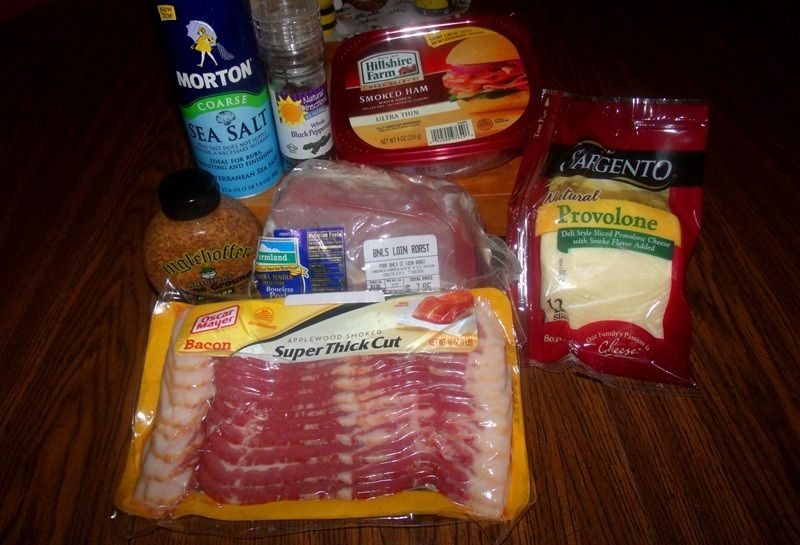
Pretty easy stuff here; a 2-pound-ish section of pork loin, thick-sliced smoked bacon, thin-sliced smoked ham, provolone cheese, some good German-style mustard (if you want), salt and pepper. Optionally, you can also have some kajmak (or acceptable substitute as noted above) on hand for serving. We didn’t have any handy, so we skipped the kajmak.
The first thing to do is to get a few slices of smoked, thick-sliced bacon going. Raichlen reports that in Kosovo and Serbia, a thick smoky bacon is used, and is usually un-cooked. I will leave that choice up to you, but would recommend that if you are using American bacon, at least brown it lightly before using; if you can get your hands on some old-school, country-style slab bacon, so much the better - but whatever you have available will do just fine. I used a typical thick-sliced bacon; the recipe says to use 3 to 4 slices, so I used 5:
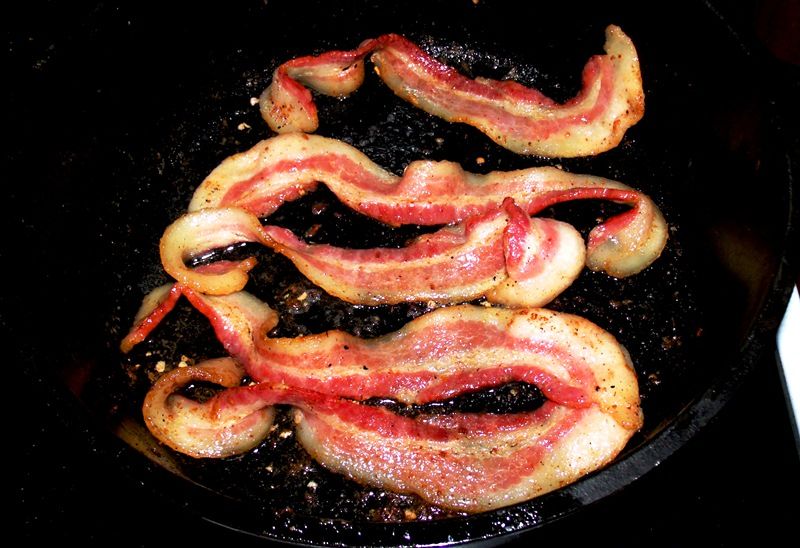
Six slices, or perhaps even 8, might have been even better! But then again, you don’t want to overfill the pork loin, due to the dangers of blow-out, so maybe it’s best not to go too crazy.
When the bacon is done to the point you are looking for, set it aside on a few paper towels to drain and cool. If you’re trying to keep this somewhat traditional, you want to cook the bacon just until it’s done and not much further:
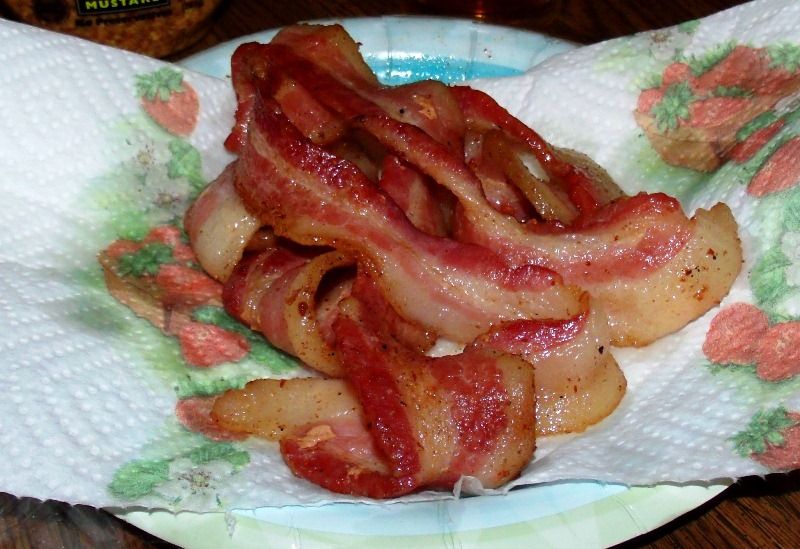
If I would have been thinking, I might have trimmed off the fatty end sections from the slices of bacon before cooking. I might try it sometime, for comparison, but it’s not a terribly important detail. You can certainly leave them on as well, if you prefer.
Anyway, the next step is to get your pork loin butterflied so that it can be stuffed. As the old saying goes, there are various methods that can be employed in order to accomplish the removal of the epidermal layers of a feline; indeed, it is quite easy to make this step a lot more elaborate and complicated than it needs to be. My goal is to provide an easy and efficient way to stuff a section of pork loin and cook it over a fire, so I will confine the discussion more or less to that end. Below are three ways that you could choose to butterfly a pork loin with a minimum of fuss for this recipe; the first two are effective, but the third would be considered the most traditional to Serbian methods and techniques, and is the method that I recommend.
First, take a look at your pork loin:
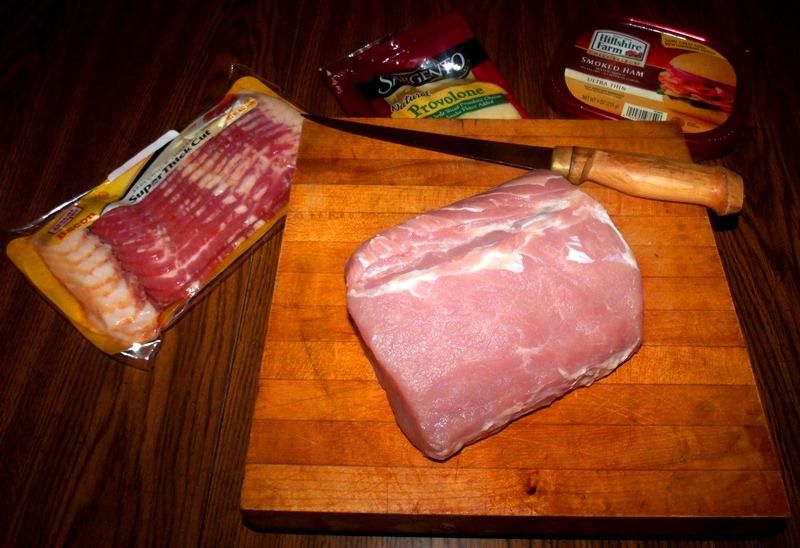
At first, I wasn’t terribly happy with the cut/shape of this particular pork loin - it seemed a little too “wide” to me - but I can’t argue with the ultimate results. It worked very well and tasted absolutely amazing, so you won’t hear me complaining too much.
The first method of butterflying a pork loin that we will look at is possibly the easiest and most basic way to accomplish the task, requiring only one cut. Simply lay the loin on a cutting board - fat cap up - and treat the loin like a subway sandwich; slice it lengthwise through the middle with your knife parallel to the cutting board - from one “long” side almost through to the other. Be sure to leave about 1/2-inch of uncut meat to act as a “hinge” when you open up the loin like a book. Here’s a visual example:
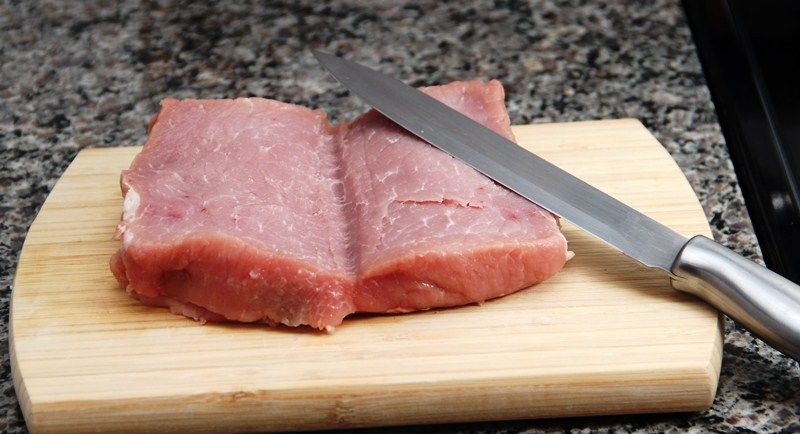
Photo Credit: http://thescrumptiouspumpkin.com/wp-...8278720186.jpg
As I said, this method is pretty easy, so it pretty much speaks for itself.
The second method is a little more tricky, but still basically quite easy, requiring only three cuts. Lay the loin on a cutting board - fat-cap up - oriented so that the end of the loin is facing you, and the length of it points away in front of you. Center your knife straight ahead of you along the top of the loin with the blade perpendicular to the cutting board and cut straight down to halfway through the loin. Then, turn the knife to the left or the right - so that it is parallel to the cutting board - and slice outward through the middle of the loin almost to the edge. Once again, be sure to leave about a half-inch of loin to act as a hinge. Now bring your knife back to the middle cut and repeat the cut in the opposite direction towards the other side, leaving a half-inch of meat as before. These three cuts will allow you to open both sides of the loin outward from the middle, so that the pork loin will once again look like an open book. Here’s a visual example:
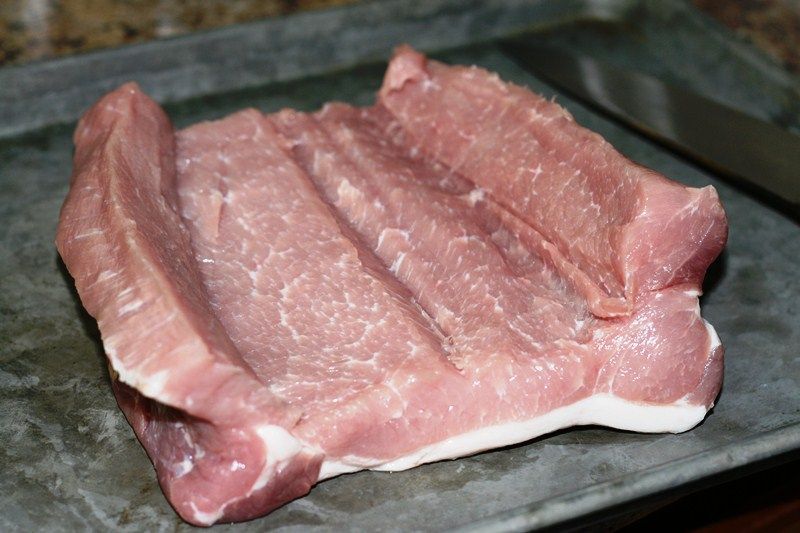
Photo Credit: http://dinnersreadyarkansas.com/blog...8/IMG_2198.jpg
As mentioned above, this method is slightly more complicated, but not overly-so; if you are judicious knife with your knife work - and don’t go over-board on the hinges - it will work just fine.
According to Raichlen, in Serbia they butterfly pork loins a little differently; the Serbian pitmaster that Raichlen learned from uses an entire loin, cutting from where it tapers down almost to a point. If your pork loin has a tapered or “thin” end, start there; looking at the photo above, mine was slightly tapered on the right, so that’s where I began:
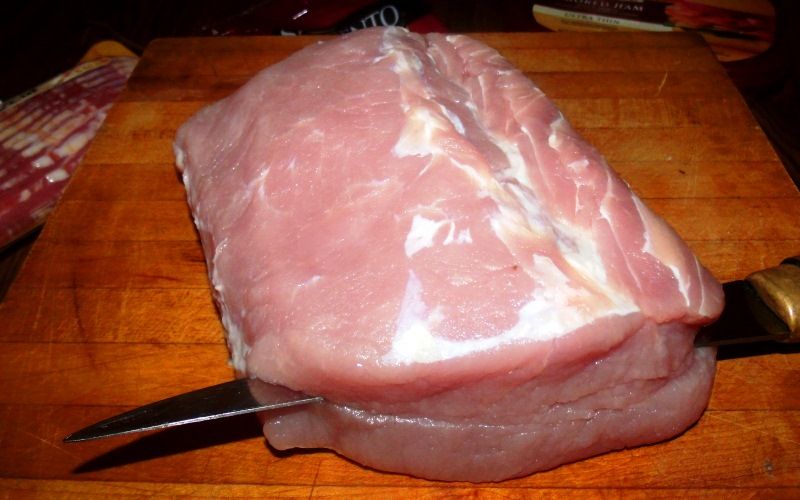
Instead of cutting from side-to-side on the loin - as is done for the first method - start at the thin or tapered end of the loin, centering your knife parallel to the cutting board, and split the loin down its length toward the wider end - almost in half - until you get half an inch or so from the wider end, leaving your hinge.
This third method stays true to the origins of punjena vešalica and is described by Raichlen as the traditional Serbian way to butterfly a pork loin; for that reason - and because it is very easy (requiring only one cut) - it is the method that I recommend for this recipe, although any of the three methods outlined will work.
I know that there are several more methods of butterflying a pork loin; indeed, when I was doing my research on different methods, a lot of the Googled photos that I found show the butterflying going further, to the point where the loin is flattened out completely. This is normal if you are going to roll it, but for "sandwiching" a loin, it's too much; my advice is to keep it simple: just the one cut (three cuts, if you elect to use the second method), then flatten the loin and stuff it. For the purposes of this recipe and method, I do believe that these are the easiest and most efficient ways to accomplish the task; the third, Serbian method is the one that I recommend as the most traditional method and the one that brings the best results in my opinion. It is easy to do and allows the sections of loin to “fit” with the filling, which I contend will result in more consistent and even-sized slices when you cut the roast. Having said that, you are of course free to use the method of your choice. In the final analysis, the actual method isn't that important - a butterflied loin is a butterflied loin - but if you want to keep it Serbian, the third method is the way to go.
As an aside, you might be asking yourself, why not roll the filling up in the pork loin? Well, that’s a good question; rolling and tying is definitely an option that would be do-able if you want to, and it does make for a very attractive presentation; however, if you do this, you might want to reduce the cooking temperature and lengthen the cooking time. Keep in mind that when you roll a pork loin, you’re going to have uncooked pork that is on the inside of the roll, along with the already-cooked bacon and ham (and of course the cheese) inside, so the whole thing will take longer to cook until the pork inside is done, necessitating a lower cooking temperature so that the outside doesn’t burn. It can certainly be done, I am sure - it would just be a matter of adjusting time and temperature; but it seems to me that the whole point of this Serbian method is to provide an easy, efficient alternative when grilling over coals.
(Continued below)
Punjena Vešalica
This unique, regional preparation for a stuffed and grilled pork loin is known in Serbia as punjena vešalica and is a featured recipe in Steven Raichlen’s book, Planet Barbecue!. This book is widely available through various outlets, and based on the few pages I’ve seen here and there, I highly recommend it - in fact, I just today ordered a copy through Amazon:
http://www.amazon.com/Planet-Barbecu...pr_product_top
Specifically, punjena vešalica comes from Peć, a city in western Kosovo, a region of the former Yugoslavia that is famous for its meat dishes that are grilled over an open charcoal fire fueled by wood from native plum trees. It is also a known specialty of Dva Jelena (The Two Stags), a renowned Belgrade restaurant that has been in operation since 1832. The proprietor of Dva Jelena and his pitmaster - at the time of Raichlen’s writing - are both from Peć, arriving in Belgrade as refugees from Kosovo’s war for independence from Serbia. Raichlen describes Kosovo’s smoky influence on Serbian cooking as “soulful,” and after experiencing this treasure, I would certainly have to agree.
This recipe and method first came to my attention by way of my friend Brook (HistoricFoodie), who posted it in order to introduce an easier and more efficient way to stuff and grill a pork loin:
From a presentation standpoint, little compares to a stuffed, rolled pork loin. But many cooks shy away from this method because they find the rolling and retying hard to do; also, according to some, controlling the cooking time on a grill is difficult…. Raichlen has a variation he calls "Serbian Stuffed Pork Loin," which makes the whole process easier. Instead of rolling and tying the loin, after butterflying, it is merely folded over the filling. This makes it easier to handle, obviously, and cuts the cooking time way down. Since making this the first time I've found it easy to adapt any loin-stuffing to this style.
http://foodsoftheworld.activeboards....topic1956.html
http://foodsoftheworld.activeboards....topic1956.html
As of this writing, I have made punjena vešalica twice, and I honestly find it to be the best pork-loin-specific recipe that I've ever tried - at home or dining out. It also has the advantage of being very easy to prepare, making it one of those dishes that gives incredible bang for the buck in terms of flavour and “wow factor” with dinner guests.
If you’re a little apprehensive about the thought of butterflying a pork loin, no worries! I will outline three easy methods below - with photos - including the way it is traditionally done in Serbia. By the time you’re finished reading this, you should be comfortable with one or all of these techniques; if not, just ask for any needed clarification and it will be provided.
Here is the recipe for punjena vešalica, from Steven Raichlen's Planet Barbecue!; Brook's comments and suggestions are in italicised parentheses:
Serbian Stuffed and Grilled Pork Loin
Punjena Vešalica
3 ounces (3 to 4 slices) smoky country-style bacon (I use European slab bacon, and just barely cook it)
1 piece of center-cut pork loin, about 2 lbs
Coarse salt (kosher or sea) and freshly-ground pepper
3 tablespoons Dijon style mustard, optional (Whole grain mustard works nicely, too)
3 ounces thinly-sliced smoked ham
2 ounces piquant cheese, such as Edam, Gouda, or Provolone, coarsely grated or thinly sliced (My choice is Provolone, to carry through the smoky flavor profile)
3/4 cup kajmak (similar to clotted cream, which makes a good substitute), mascarpone or sour cream, for serving, optional
Cook the bacon in a frying pan over medium heat until lightly browned and just beginning to crisp, about 2 minutes per side. Drain on paper towels and set aside
Butterfly the pork loin: Place the pork loin on a cutting board. If you’d like to do it as they do in Serbia, starting at a narrow end and holding the knife parallel to the cutting board, cut the pork loin almost in half to the other end. [Otherwise,] it may be easier to butterfly the pork loin [by] starting at one long side and cutting to, but not through, the other long side. Open up the pork loin as you would a book. Place the pork between two pieces of plastic wrap and, using a meat mallet, scaloppine pounder, or the side of a heavy cleaver, pound both loin halves into a flat sheet about 1/2-inch thick. Remove and throw away the plastic wrap.
Generously season the inside of the pork loin with salt and pepper and spread the mustard, if using, over it. Arrange the bacon over the bottom half of the open pork loin. Place the slices of ham on top (of the bacon), followed by the cheese. Fold the top half of loin back over the bottom piece. Season the outside of the loin with salt and pepper. If you like, secure the edges with toothpicks or skewers, or tie the loin with butcher’s string (I highly recommend this, especially the first time or two, until you develop a feel for turning a package like this).
Set up the grill for direct cooking and preheat it to medium-high.
When ready to cook, brush and oil the grill grate. Arrange the stuffed pork loin on the hot grate at a diagonal to the bars. Grill the pork loin until well browned and cooked to medium; the cheese should be melted and sizzling, 6-8 minutes per side. If desired, give the loin a quarter-turn after 4 minutes on each side to create a handsome crosshatch pattern. Use an instant-read thermometer to test for doneness, inserting it into the thickest part of the meat….
Transfer the grilled pork loin to a platter and remove any toothpicks, skewers or string…. Cut the loin crosswise (into slices about an inch thick) and top each serving with a spoonful of kajmak, if desired…..
Punjena Vešalica
3 ounces (3 to 4 slices) smoky country-style bacon (I use European slab bacon, and just barely cook it)
1 piece of center-cut pork loin, about 2 lbs
Coarse salt (kosher or sea) and freshly-ground pepper
3 tablespoons Dijon style mustard, optional (Whole grain mustard works nicely, too)
3 ounces thinly-sliced smoked ham
2 ounces piquant cheese, such as Edam, Gouda, or Provolone, coarsely grated or thinly sliced (My choice is Provolone, to carry through the smoky flavor profile)
3/4 cup kajmak (similar to clotted cream, which makes a good substitute), mascarpone or sour cream, for serving, optional
Cook the bacon in a frying pan over medium heat until lightly browned and just beginning to crisp, about 2 minutes per side. Drain on paper towels and set aside
Butterfly the pork loin: Place the pork loin on a cutting board. If you’d like to do it as they do in Serbia, starting at a narrow end and holding the knife parallel to the cutting board, cut the pork loin almost in half to the other end. [Otherwise,] it may be easier to butterfly the pork loin [by] starting at one long side and cutting to, but not through, the other long side. Open up the pork loin as you would a book. Place the pork between two pieces of plastic wrap and, using a meat mallet, scaloppine pounder, or the side of a heavy cleaver, pound both loin halves into a flat sheet about 1/2-inch thick. Remove and throw away the plastic wrap.
Generously season the inside of the pork loin with salt and pepper and spread the mustard, if using, over it. Arrange the bacon over the bottom half of the open pork loin. Place the slices of ham on top (of the bacon), followed by the cheese. Fold the top half of loin back over the bottom piece. Season the outside of the loin with salt and pepper. If you like, secure the edges with toothpicks or skewers, or tie the loin with butcher’s string (I highly recommend this, especially the first time or two, until you develop a feel for turning a package like this).
Set up the grill for direct cooking and preheat it to medium-high.
When ready to cook, brush and oil the grill grate. Arrange the stuffed pork loin on the hot grate at a diagonal to the bars. Grill the pork loin until well browned and cooked to medium; the cheese should be melted and sizzling, 6-8 minutes per side. If desired, give the loin a quarter-turn after 4 minutes on each side to create a handsome crosshatch pattern. Use an instant-read thermometer to test for doneness, inserting it into the thickest part of the meat….
Transfer the grilled pork loin to a platter and remove any toothpicks, skewers or string…. Cut the loin crosswise (into slices about an inch thick) and top each serving with a spoonful of kajmak, if desired…..
Anyway, as the submariners say, let’s kick this pig!
Here’s everything that you need to take a wonderful, smoky ride to Serbian deliciousness:

Pretty easy stuff here; a 2-pound-ish section of pork loin, thick-sliced smoked bacon, thin-sliced smoked ham, provolone cheese, some good German-style mustard (if you want), salt and pepper. Optionally, you can also have some kajmak (or acceptable substitute as noted above) on hand for serving. We didn’t have any handy, so we skipped the kajmak.
The first thing to do is to get a few slices of smoked, thick-sliced bacon going. Raichlen reports that in Kosovo and Serbia, a thick smoky bacon is used, and is usually un-cooked. I will leave that choice up to you, but would recommend that if you are using American bacon, at least brown it lightly before using; if you can get your hands on some old-school, country-style slab bacon, so much the better - but whatever you have available will do just fine. I used a typical thick-sliced bacon; the recipe says to use 3 to 4 slices, so I used 5:

Six slices, or perhaps even 8, might have been even better! But then again, you don’t want to overfill the pork loin, due to the dangers of blow-out, so maybe it’s best not to go too crazy.
When the bacon is done to the point you are looking for, set it aside on a few paper towels to drain and cool. If you’re trying to keep this somewhat traditional, you want to cook the bacon just until it’s done and not much further:

If I would have been thinking, I might have trimmed off the fatty end sections from the slices of bacon before cooking. I might try it sometime, for comparison, but it’s not a terribly important detail. You can certainly leave them on as well, if you prefer.
Anyway, the next step is to get your pork loin butterflied so that it can be stuffed. As the old saying goes, there are various methods that can be employed in order to accomplish the removal of the epidermal layers of a feline; indeed, it is quite easy to make this step a lot more elaborate and complicated than it needs to be. My goal is to provide an easy and efficient way to stuff a section of pork loin and cook it over a fire, so I will confine the discussion more or less to that end. Below are three ways that you could choose to butterfly a pork loin with a minimum of fuss for this recipe; the first two are effective, but the third would be considered the most traditional to Serbian methods and techniques, and is the method that I recommend.
First, take a look at your pork loin:

At first, I wasn’t terribly happy with the cut/shape of this particular pork loin - it seemed a little too “wide” to me - but I can’t argue with the ultimate results. It worked very well and tasted absolutely amazing, so you won’t hear me complaining too much.
The first method of butterflying a pork loin that we will look at is possibly the easiest and most basic way to accomplish the task, requiring only one cut. Simply lay the loin on a cutting board - fat cap up - and treat the loin like a subway sandwich; slice it lengthwise through the middle with your knife parallel to the cutting board - from one “long” side almost through to the other. Be sure to leave about 1/2-inch of uncut meat to act as a “hinge” when you open up the loin like a book. Here’s a visual example:

Photo Credit: http://thescrumptiouspumpkin.com/wp-...8278720186.jpg
As I said, this method is pretty easy, so it pretty much speaks for itself.
The second method is a little more tricky, but still basically quite easy, requiring only three cuts. Lay the loin on a cutting board - fat-cap up - oriented so that the end of the loin is facing you, and the length of it points away in front of you. Center your knife straight ahead of you along the top of the loin with the blade perpendicular to the cutting board and cut straight down to halfway through the loin. Then, turn the knife to the left or the right - so that it is parallel to the cutting board - and slice outward through the middle of the loin almost to the edge. Once again, be sure to leave about a half-inch of loin to act as a hinge. Now bring your knife back to the middle cut and repeat the cut in the opposite direction towards the other side, leaving a half-inch of meat as before. These three cuts will allow you to open both sides of the loin outward from the middle, so that the pork loin will once again look like an open book. Here’s a visual example:

Photo Credit: http://dinnersreadyarkansas.com/blog...8/IMG_2198.jpg
As mentioned above, this method is slightly more complicated, but not overly-so; if you are judicious knife with your knife work - and don’t go over-board on the hinges - it will work just fine.
According to Raichlen, in Serbia they butterfly pork loins a little differently; the Serbian pitmaster that Raichlen learned from uses an entire loin, cutting from where it tapers down almost to a point. If your pork loin has a tapered or “thin” end, start there; looking at the photo above, mine was slightly tapered on the right, so that’s where I began:

Instead of cutting from side-to-side on the loin - as is done for the first method - start at the thin or tapered end of the loin, centering your knife parallel to the cutting board, and split the loin down its length toward the wider end - almost in half - until you get half an inch or so from the wider end, leaving your hinge.
This third method stays true to the origins of punjena vešalica and is described by Raichlen as the traditional Serbian way to butterfly a pork loin; for that reason - and because it is very easy (requiring only one cut) - it is the method that I recommend for this recipe, although any of the three methods outlined will work.
I know that there are several more methods of butterflying a pork loin; indeed, when I was doing my research on different methods, a lot of the Googled photos that I found show the butterflying going further, to the point where the loin is flattened out completely. This is normal if you are going to roll it, but for "sandwiching" a loin, it's too much; my advice is to keep it simple: just the one cut (three cuts, if you elect to use the second method), then flatten the loin and stuff it. For the purposes of this recipe and method, I do believe that these are the easiest and most efficient ways to accomplish the task; the third, Serbian method is the one that I recommend as the most traditional method and the one that brings the best results in my opinion. It is easy to do and allows the sections of loin to “fit” with the filling, which I contend will result in more consistent and even-sized slices when you cut the roast. Having said that, you are of course free to use the method of your choice. In the final analysis, the actual method isn't that important - a butterflied loin is a butterflied loin - but if you want to keep it Serbian, the third method is the way to go.
As an aside, you might be asking yourself, why not roll the filling up in the pork loin? Well, that’s a good question; rolling and tying is definitely an option that would be do-able if you want to, and it does make for a very attractive presentation; however, if you do this, you might want to reduce the cooking temperature and lengthen the cooking time. Keep in mind that when you roll a pork loin, you’re going to have uncooked pork that is on the inside of the roll, along with the already-cooked bacon and ham (and of course the cheese) inside, so the whole thing will take longer to cook until the pork inside is done, necessitating a lower cooking temperature so that the outside doesn’t burn. It can certainly be done, I am sure - it would just be a matter of adjusting time and temperature; but it seems to me that the whole point of this Serbian method is to provide an easy, efficient alternative when grilling over coals.
(Continued below)


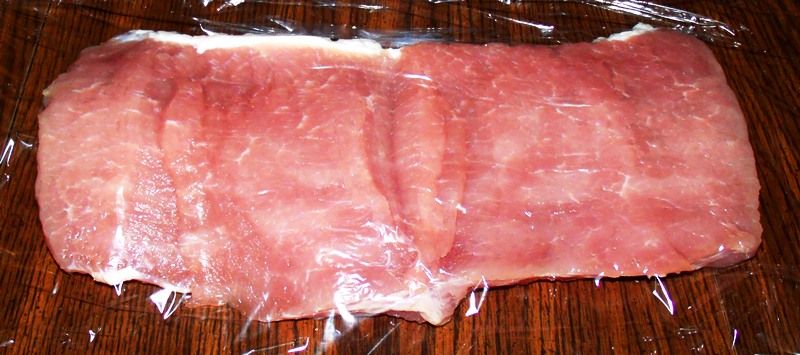
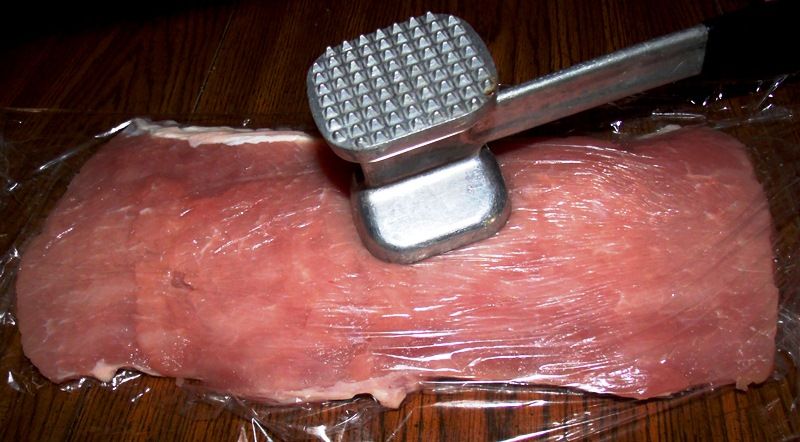
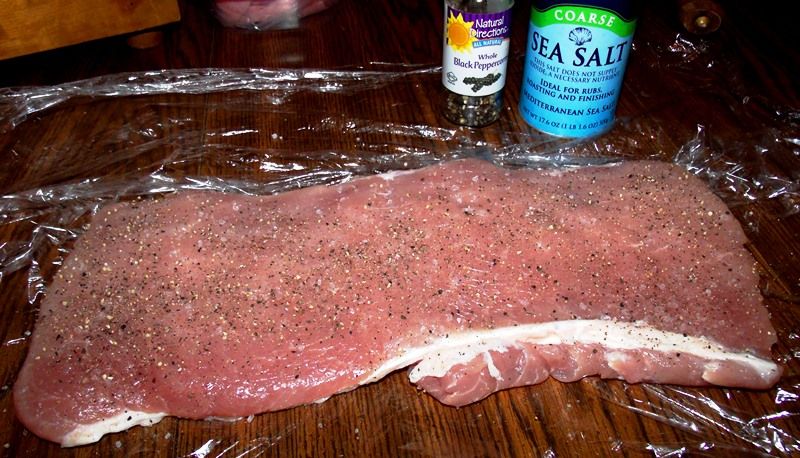
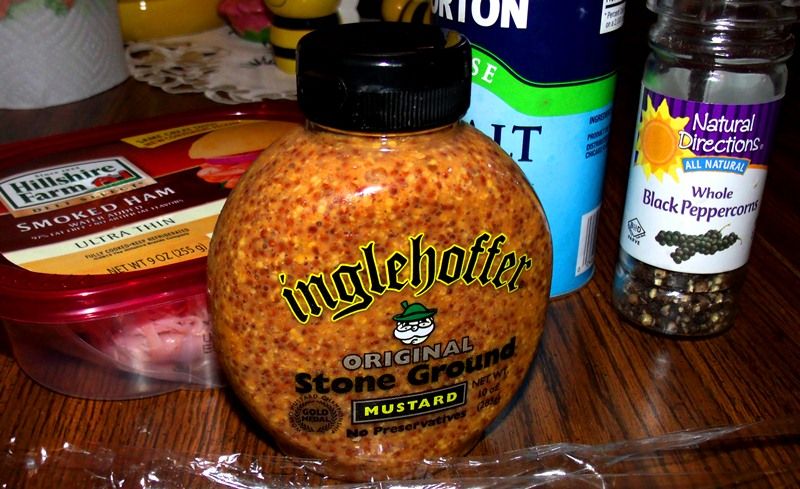
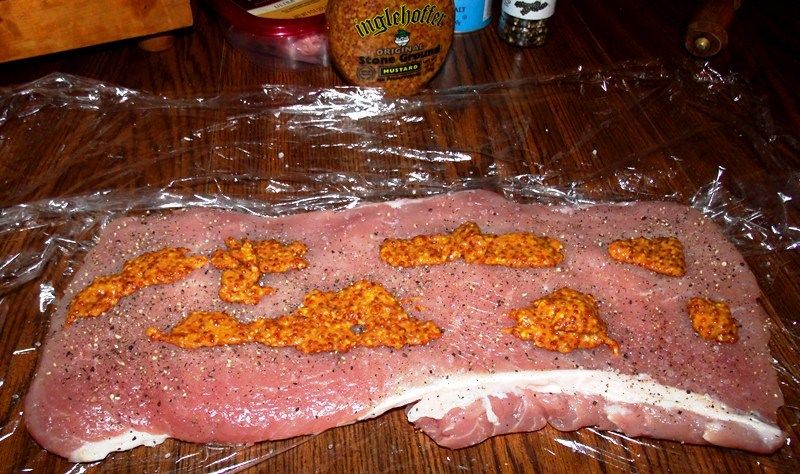
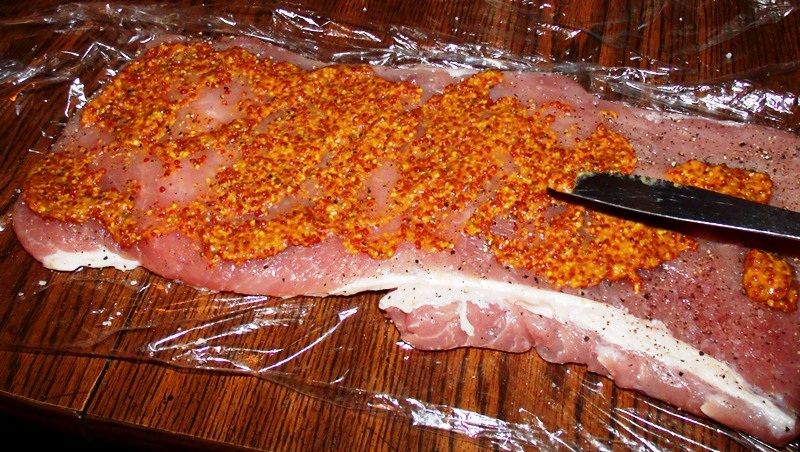
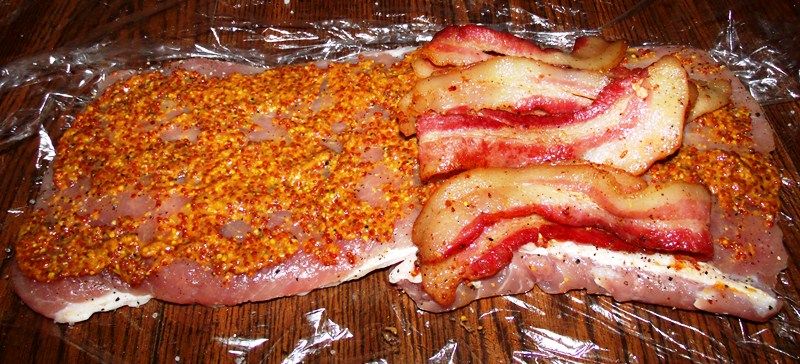
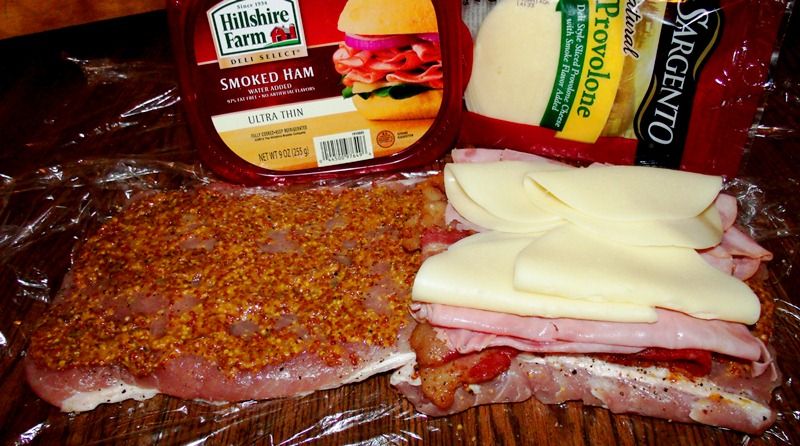
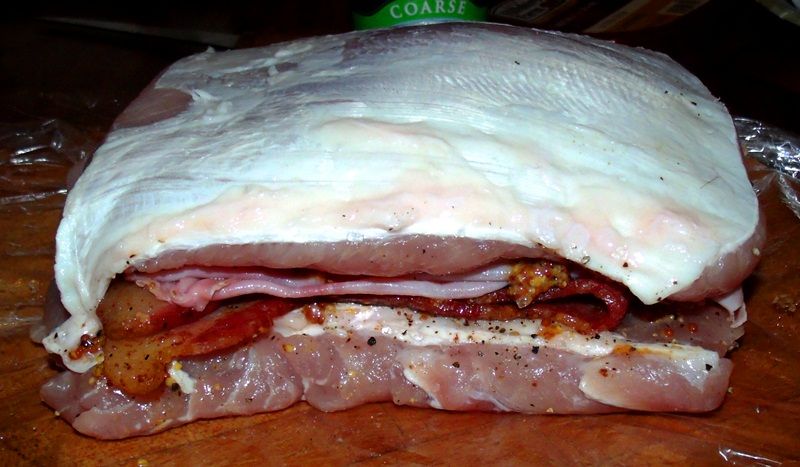
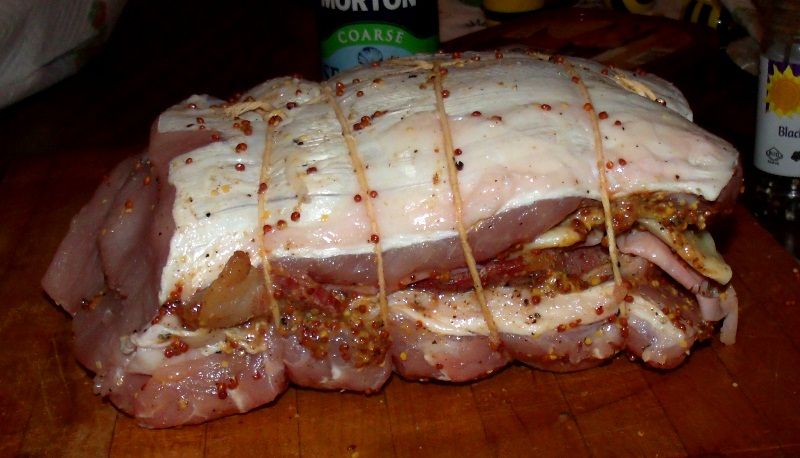
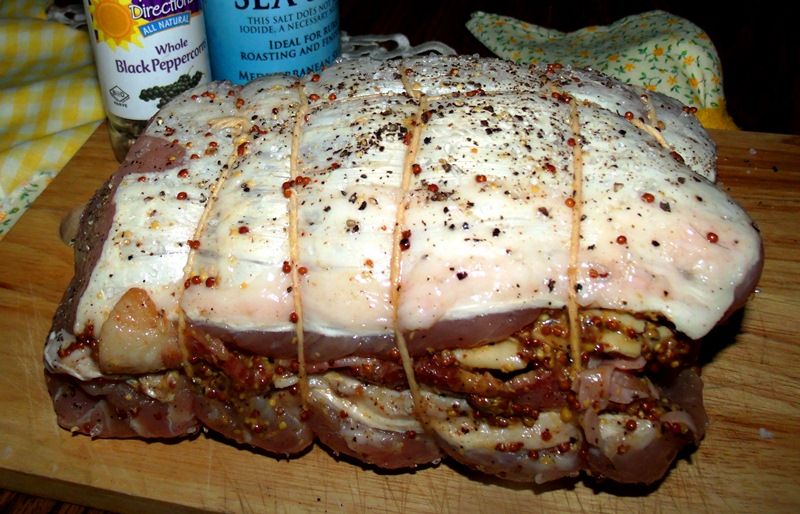
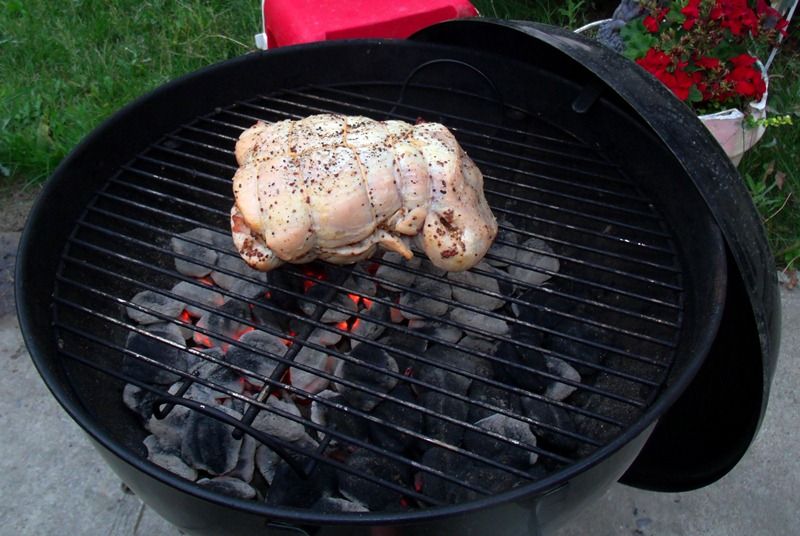
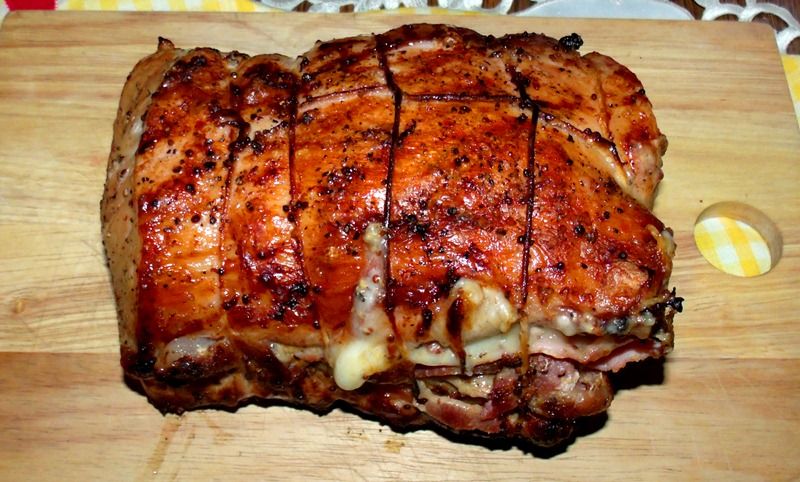
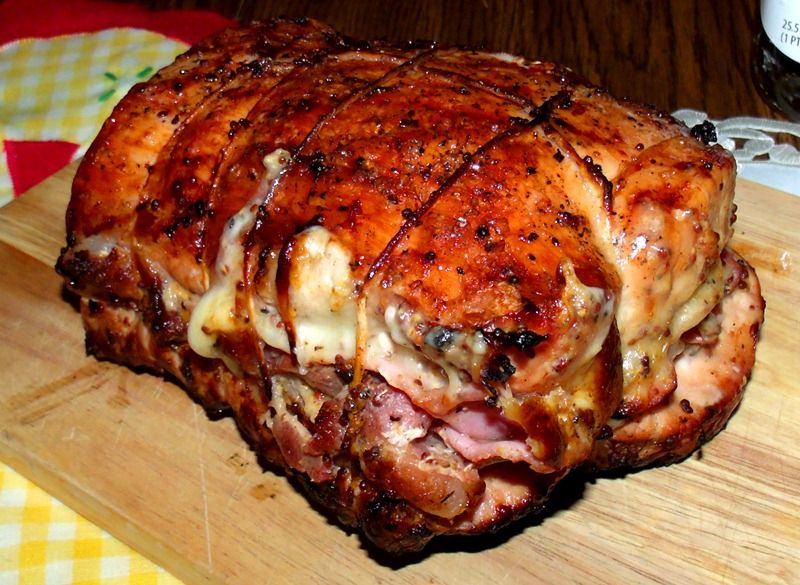
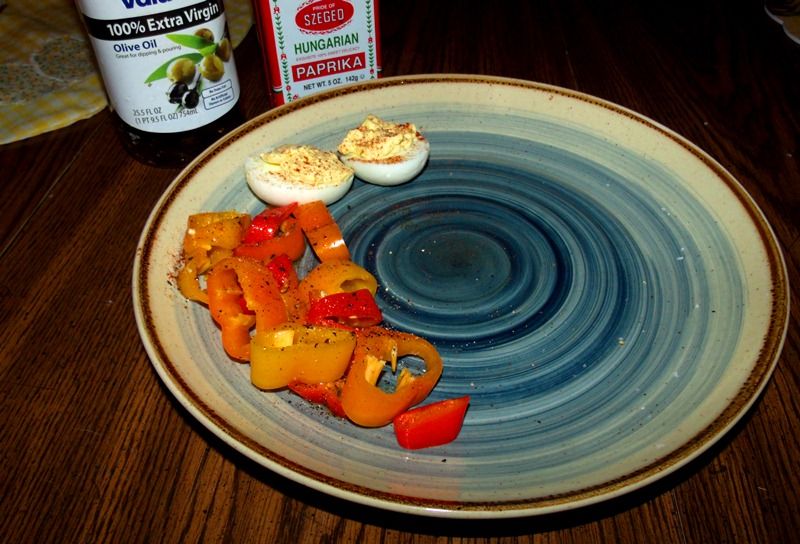
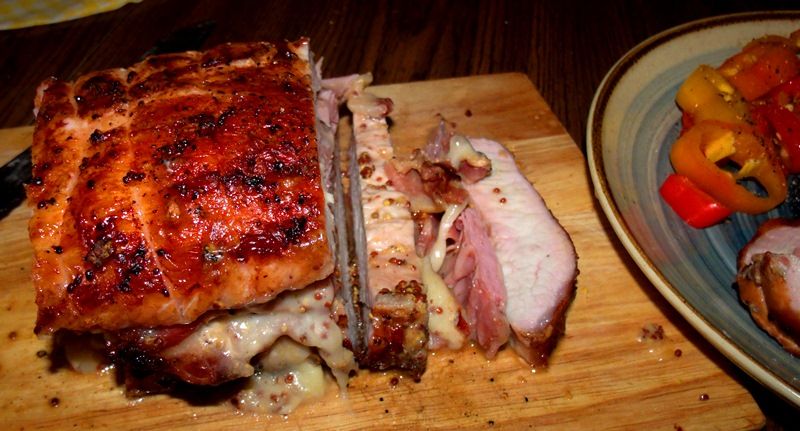
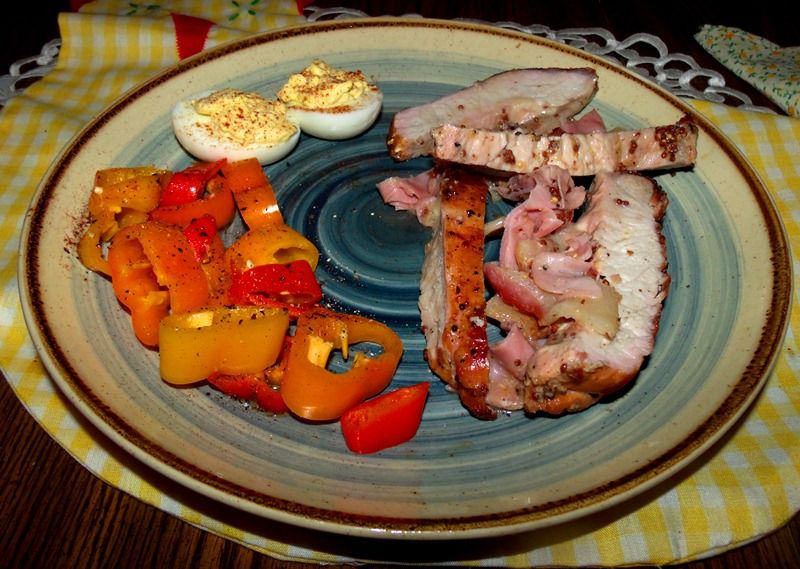
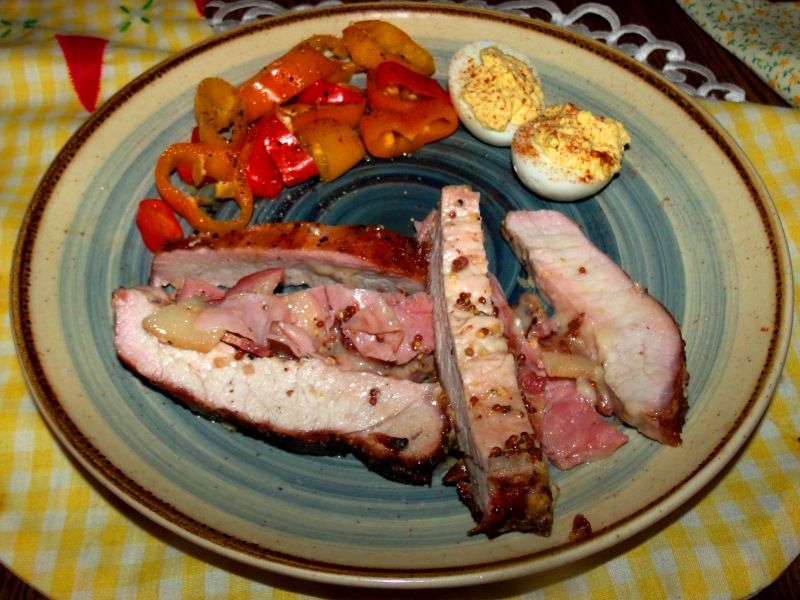
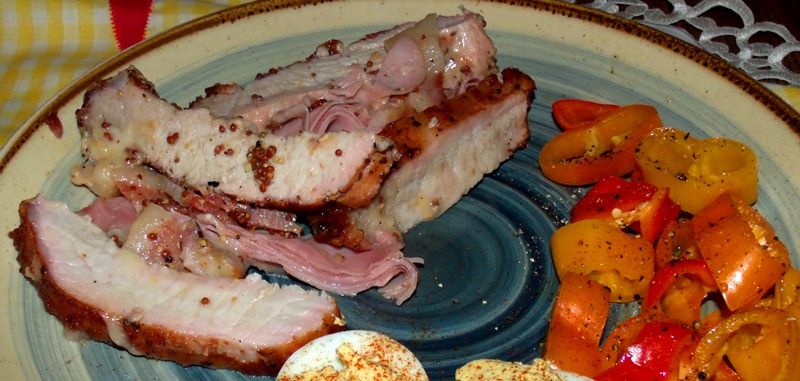







Comment